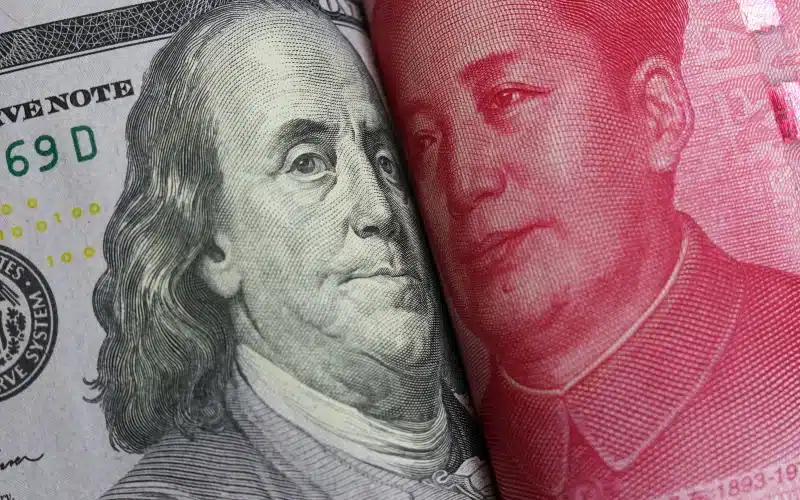The financial relationship between the United States and China is among the most important and complex in the world economy. The fact that China holds a significant quantity of US debt is essential to this relationship. When considering the issue, “How much money does the United States owe China?” it is critical to remember that this sum represents more than a simple financial transaction; it indicates a fundamental interdependence between two of the world’s main economic powers. This article will present a complete study of the United States’ debt to China, looking at not only the raw statistics but also the broader economic and geopolitical ramifications that are frequently overlooked. Understanding this dynamic is critical for professionals in a variety of professions since it affects global markets, international relations, and economic plans.
How Much Money Does the US Owe China?

When we say that China owes the United States money, we mean the amount of debt that China has in the form of Treasury securities. According to the latest recent figures, the US owes China around $980 billion in these securities. But what does this mean, and why is it important?
Breaking down the $980 billion
US Treasury securities are effectively IOUs issued by the US government to fund its operations, which range from infrastructure projects to social security payments. These securities are available in a variety of US forms, including Treasury bills (short term), Treasury notes (medium term), and Treasury bonds (long term), all of which pay interest to their holders. China, with its large trade surplus, has made significant investments in these assets throughout the years.
The $980 billion number accounts for a large fraction of the overall US national debt, which surpasses $33 trillion. However, it is vital to put this statistic in context.
China is the second-largest foreign holder of US debt, trailing only Japan. China and Japan collectively own more than one-third of all foreign-held U.S. Treasury securities. This makes China a key player in the US debt market.
- Percentage of Total US Debt: While $980 billion sounds like a lot of US debt, it only accounts for around 3% of the total. This indicates that while China has sizable holdings, domestic investors or other foreign investors hold the vast majority of US debt.
- Why China Buys US Debt: China’s significant holdings of US debt are mostly the result of its trade practices. China sells substantially more to the US than it imports, resulting in a trade surplus. The United States pays for these goods in dollars, which China then uses to purchase U.S. Treasury securities. This not only helps China maintain its currency (the yuan), but it also provides a safe and liquid investment for the country’s large foreign reserves.
Read Also: What Is a Debenture Bond? Definition & Types
Implications of Debt
The $980 billion debt has far-reaching consequences.
- Economic Interdependence: The debt fosters a symbiotic connection between the United States and China. The United States relies on China to purchase its debt, which helps to keep interest rates low and funds government spending. Meanwhile, China depends on the stability and security of the United States. Treasury bonds are used to secure the country’s foreign exchange reserves.
- Potential hazards: Although the partnership is mutually beneficial, it also has hazards. If China sells a large amount of its US debt, interest rates could rise and destabilize the global financial markets. However, such a move would harm China by devaluing its remaining holdings and potentially triggering a financial crisis.
- Strategic leverage: Some observers believe China’s holdings give it a strategic advantage over the United States. However, China’s leverage is restricted because any extreme action could have a detrimental impact on its economy.
Read Also: Economy Recession: Definition, Causes, Effects & Solution
The Origins of the U.S. Debt to China
To fully comprehend the severity of this debt, we must first understand how we got here. The United States began accumulating enormous debt to China in the early 2000s, as a result of the global economic boom and China’s rapid rise as an export powerhouse. China, with its massive trade surplus, required a secure location to store its foreign exchange reserves, as did the United States. Treasury securities were exactly that: dependable, low-risk investments with reasonable yields.
What many people are not aware is that this debt is not always indicative of economic decline. Instead, it represents a symbiotic relationship in which both countries benefit: the United States obtains access to low-cost money to pay its deficit, while China secures its investments in the world’s most stable currency.
Why Does the United States Owe China So Much Money?

The United States owes China a large sum of money, primarily due to the two countries’ trade deficits. For years, the United States has bought significantly more items from China than it has exported, resulting in a trade deficit. China, with its large trade surplus, then spends the funds earned to buy U.S. Treasury securities. The United States has a sizable debt to China as a result of this cycle.
However, the story does not finish here. While it may appear worrying that a foreign power owns such a huge part of US debt, it is vital to remember that this debt is also an investment for China. By holding the U.S., China is effectively banking on the US economy’s stability and strength by issuing Treasury bonds. It’s a complicated relationship, and both countries have a great stake in each other’s economic success.
The Actual Impact of U.S. Debt to China
Most debates about US debt to China center on the risks—what happens if China decides to liquidate its Treasury holdings? While this is a valid concern, it is also a little overblown. If China were to abruptly sell its US assets, it would produce short-term market disturbances, but would also devalue the bonds it owns, damaging its finances. Furthermore, the United States has a robust and liquid bond market capable of mitigating such shocks.
What is less discussed is how the debt affects US foreign policy and economic strategy. For example, while negotiating trade with China, the United States must take into account its debt obligations. This debt also has an impact on global banking, since the US dollar’s dominance is bolstered by foreign investors’ faith in US debt, especially China.
Common Misconceptions About the US Debt to China
#1. The United States is in danger of defaulting to China:
One of the most persistent misunderstandings is that the United States will default on its financial obligations to China. This belief is mostly false for various reasons:
- Historical Context: The United States has a lengthy record of meeting its debt obligations. Since the founding of the United States. Treasury: The country has never defaulted on its debt. This track record has helped establish the United States. Treasury securities are considered one of the safest investments in the world.
- Monetary Sovereignty: The United States government issues debt using its currency, the US dollar. Because of this, the U.S. Treasury has the unique capacity to issue extra money as needed to pay its debt obligations. While this technically guarantees that the United States will always be able to repay its obligations, it is not a risk-free method. Printing more money might lead to inflation, reducing the value of the dollar and potentially destabilizing the economy. However, the United States government carefully supervises this process to avoid such consequences.
- Global trust: The global financial community has high trust in the US economy and its capacity to handle debt. This trust is reflected in the sustained demand for the United States. Investors purchase Treasury securities all over the world, not just in China. This demand helps to keep interest rates low and assures that the United States can continue to service its debt without facing a serious risk of default.
In essence, the chance of the United States defaulting on its debts to China is quite low. The United States has the resources and economic stability to satisfy its debts, making default improbable.
#2. China can control the United States by holding its debt
Another prevalent misperception is that China’s large holdings of US debt give them tremendous influence over US policies. While it is true that China owns a significant proportion of U.S. Treasury securities, this does not imply direct control over US activities for various reasons:
- Financial Instrument vs. Political Tool: US Treasury securities are financial instruments designed to provide profits for investors, not tools for wielding political power. The debt is China’s investment in the stability and strength of the US economy. If China attempts to use its holdings as leverage, it risks upsetting global financial markets, and harming China’s economic interests.
- Self-Interest: Selling a major amount of the United States’ debt holdings would most likely result in a decrease in the value of those securities, lowering the value of China’s assets. Furthermore, such a move could result in higher interest rates, increasing borrowing costs for the US government. However, because the global economy is interconnected, rising interest rates in the United States may hinder global economic growth, affecting China’s export-driven economy.
- Economic Interdependence: The United States and China are economically linked. The United States depends on China as a major debt holder, while China relies on the United States as an important export market and a source of safe, steady investments. This reciprocal dependency ensures that both countries have a vested stake in the stability of their economic partnership.
Thus, while China’s holdings of US debt are substantial, they do not provide China with direct power over US policy. The relationship is multifaceted and motivated by mutual economic interests rather than political supremacy.
#3. The debt is unmanageable
The amount of the United States national debt, particularly the share held by foreign countries such as China, frequently raises fears that it is unmanageable. However, this perspective does not take into consideration numerous important factors:
- Debt-to-GDP Ratio: One of the most essential criteria for determining the manageability of national debt is the debt-to-GDP ratio, which compares a country’s debt to its economic output. While the US debt is considerable, the US economy is the world’s largest, with a GDP of more than $25 trillion. This suggests that the United States has a strong economic base to support its debt. The debt-to-GDP ratio is high, but it is not unusual for a major country, and it is still within the range that many economists consider sustainable.
- Economic Growth: The US economy is still expanding, which helps manage the debt burden. As long as the economy expands faster than the debt, the debt’s relative burden will diminish over time. Economic growth generates more tax money, which can be used to service and reduce debt.
- Global demand for the United States. Debt: US Treasury securities are regarded as one of the world’s safest investments. This demand assures that the United States can continue to issue debt at relatively low interest rates, making it easier to manage debt over time. Furthermore, many other countries and institutions, not only China, own US debt, so diversifying the risk.
- Fiscal Policy: The United States government has a variety of tools at its disposal to control debt, including fiscal policy actions such as lowering tax rates, reducing government expenditure, and enacting budgetary reforms. If your debt problems worsen, you can utilize these techniques to address them.
While the United States national debt is significant, it is crucial to consider it in the context of the larger economy. The debt remains manageable due to the size of the US economy, its potential for expansion, and the continuous global demand for US products. Treasury securities.
Why Understanding the US Debt to China Matters
Understanding the subtleties of the United States’ debt to China is critical for experts in finance, economics, and international relations. Knowing the figures is not enough; you must also understand the geopolitical and economic ramifications. This information can give you a substantial advantage when advising clients, making investing decisions, or developing policies.
To help you analyze such intricate financial relationships, I recommend using a Debt Analysis Template. This tool allows you to break down various financial commitments, understand their ramifications, and make better decisions. Whether you’re dealing with national debt or corporate liabilities, this template can help you outline your analysis.
What would happen if China sold all of its US debt?
If China sold all of its US debt, the bond market would see short-term problems. However, it would also devalue the bonds they own, harming China’s financial position.
Why does China purchase US debt?
China buys US debt to invest its foreign exchange reserves in a secure and stable asset. U.S. Treasury bonds provide low-risk yields, making them an appealing option for countries with huge trade surpluses, such as China.
Is the United States at risk of defaulting on its debt to China?
No, the United States is not at risk of defaulting on its debt to China. The United States government can satisfy its debt obligations, and Treasury securities enable the government to manage its debt properly.
How does the United States’ debt to China affect the world economy?
The US debt to China has a tremendous impact on the global economy, influencing everything from international trade discussions to the stability of global financial markets. The interconnectedness of the two economies is critical to ensuring global economic stability.
Key Takeaways
- The United States owes China around $980 billion in Treasury securities, making it one of the largest foreign holders of US debt.
- The debt represents a complex economic relationship in which both countries benefit from stability and growth.
- Beyond the figures, the US debt to China has far-reaching ramifications for global banking and international politics.
- Common fallacies, such as the assumption that China dominates the United States through its debt holdings, are mainly untrue.
Conclusion
An intriguing and crucial aspect of global finance is the relationship between the United States and China, which is in part defined by the significant debt that the United States owes. While the figures are astonishing, the consequences are even more serious. Understanding these dynamics provides insights into both the current state of events and the future of global economic stability. How do you envision the US-China financial relationship evolving in the next few years?
- TRADE WAR: How Did The Trade War Begin?
- CAPITAL CONTROLS: BEST PRACTICES WITH PRACTICAL EXAMPLES
- HOW TO BUY I BONDS FROM TREASURY: All You Should Know
- HOW TO BUY TREASURY BONDS: What You Should Know & Guide






